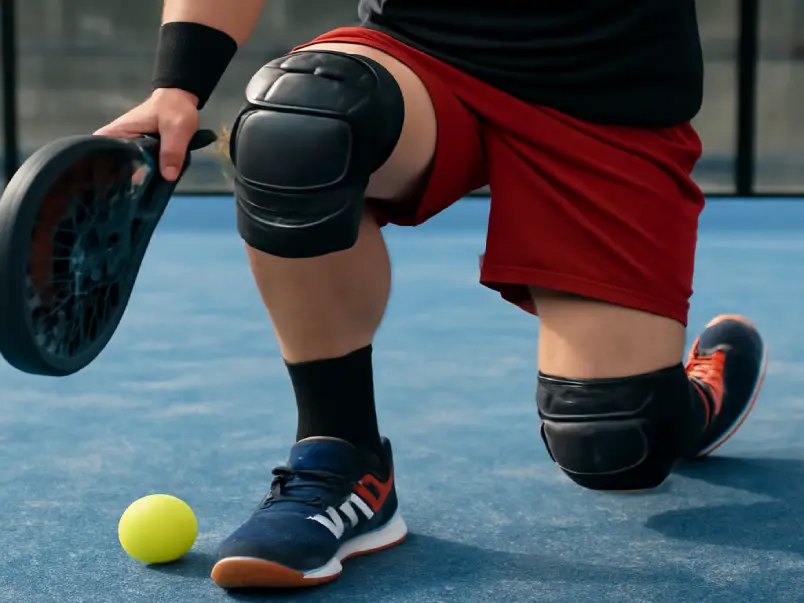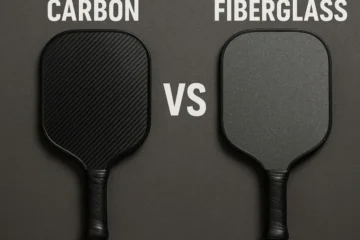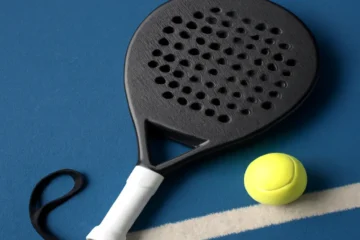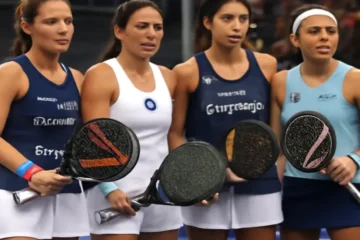Padel is an exhilarating sport, with its fast-paced gameplay and demanding movements. Whether you’re making those last-minute lunges or diving for a shot, every action can take a toll on your knees. If you’ve ever experienced the intense strain of quick directional changes or abrupt stops, you know how hard padel can be on your body—especially your knees.
The Hard Court Challenge
Hard courts, made of materials like cement or artificial grass with sand, present unique challenges for padel players. Unlike clay or grass courts, hard surfaces can be unforgiving. The combination of impact from falls and abrasion from the rough surface puts extra stress on the joints. It’s no surprise that knee injuries are a common concern for players, especially when playing on these tougher surfaces.
This is where knee pads come in—not just as an accessory but as an essential piece of equipment. With proper knee protection, you can confidently play without constantly worrying about injury, ensuring both safety and performance.
1. Not All Knee Pads Are Created Equal: What to Look For
When choosing knee pads for padel, it’s essential to consider several key features that will provide the right balance of protection, comfort, and durability. Let’s dive into what you should look for when selecting the perfect pair.
A. Impact Protection & Cushioning
Impact protection is arguably the most important factor in selecting knee pads for hard courts. Hard surfaces, when collided with, can cause damage to the knee joint. That’s why a knee pad’s cushioning plays a pivotal role in protecting against these impacts.
Types of padding include:
- Gel: Known for providing excellent shock absorption and contouring to the knee’s shape.
- EVA Foam: Lightweight and flexible, EVA foam provides an optimal balance of cushioning and durability.
- D3O®: A high-tech material that hardens upon impact, offering superior protection while maintaining flexibility during normal movement.
The best knee pads will feature padding that absorbs impact, ensuring minimal risk of injury when you fall or dive.
B. Durability & Abrasion Resistance
Playing on hard courts means you’re bound to slide, dive, and move at high speeds. For this reason, the durability of the knee pad’s outer shell is critical. Materials like reinforced fabric and hard plastic caps ensure that the knee pad can withstand abrasions from both the court surface and the repetitive motion of sliding.
It’s important to look for materials that won’t degrade over time, even after repeated use on abrasive surfaces.
C. Fit, Comfort, and Breathability
A well-fitting knee pad is essential for long-term comfort and effectiveness. Knee pads should fit snugly without restricting movement or circulation. A poor fit may lead to slipping, bunching, or chafing, which can disrupt your game.
Key points to consider:
- Sizing: Choose knee pads that fit well, with size charts available for reference.
- Sleeve vs. Strap Designs: Sleeve-style knee pads offer a snug, supportive fit, while strap designs allow for better customization.
- Moisture-Wicking Materials: Look for knee pads that feature moisture-wicking fabrics to reduce sweating, prevent slippage, and enhance comfort during long matches.
D. Freedom of Movement
Padel requires quick, explosive movements, so your knee pads should never impede your ability to bend, sprint, or pivot. Look for low-profile designs that provide protection without adding bulk. Flexibility is essential—especially if you’re a player who values speed and agility on the court.
E. Stability
A good knee pad should stay in place during dynamic movements. Look for non-slip silicone grips or secure straps that ensure the knee pad doesn’t shift while you’re on the move.
2. Top Picks: The Best Padel Knee Pads for Hard Courts
Let’s explore the top knee pads that stand out for their performance on hard courts, combining comfort, durability, and protection.
A. The All-Round Performer: Bullpadel Antivibes Knee Pads
Key Features:
- Gel padding for superior shock absorption
- Breathable, moisture-wicking fabric
- Low-profile design for comfort and agility
Pros:
- Balanced protection and comfort
- Ideal for recreational players
- Trusted brand with high-quality materials
Cons:
- Slightly less durable than other options for aggressive players
Best For:
Recreational padel players who seek a solid all-around knee pad with good cushioning and comfort without breaking the bank.
B. The Maximum Protection Shield: McDavid Hex Knee Pads
Key Features:
- Advanced hexagonal foam for shock dispersion
- Reinforced outer shell for abrasion resistance
- Adjustable straps for secure fit
Pros:
- Excellent for players with existing knee injuries or frequent falls
- Superior impact protection
- Durable and robust design
Cons:
- Bulkier than other models, may hinder mobility for some players
Best For:
Padel players who frequently dive or have existing knee issues, requiring maximum protection from impacts and abrasions.
C. The Lightweight & Discreet Choice: Nike Pro Elite Knee Pads
Key Features:
- Low-profile, minimalistic design
- EVA foam padding for lightweight cushioning
- Stretch fabric for a snug, comfortable fit
Pros:
- Offers excellent protection without the bulk
- Great for players who prioritize mobility
- Breathable and moisture-wicking
Cons:
- Less impact protection than bulkier models
Best For:
Competitive players who need knee protection but don’t want to compromise on mobility.
D. The Durable Workhorse: Decathlon Kipsta Knee Pads
Key Features:
- Strong abrasion-resistant outer layer
- High-density foam for protection
- Affordable and reliable design
Pros:
- Great value for money
- Ideal for beginners or players on a budget
- Reliable durability for hard court surfaces
Cons:
- May not provide the same level of advanced protection as higher-end models
Best For:
Beginners and recreational players seeking durable knee protection at an affordable price.
E. The Professional’s Choice: Varlion Pro Knee Pads
Key Features:
- High-quality stitching and superior materials
- Ergonomic design for enhanced comfort
- Maximum shock absorption with D3O® technology
Pros:
- Top-tier protection and performance
- Designed for serious, competitive players
- Highly durable and comfortable for long sessions
Cons:
- Premium price tag
Best For:
Advanced, competitive players who demand the best in knee protection for high-performance padel.
3. Comparison Table at a Glance
| Product Name | Best For | Protection Level | Key Material | Breathability | Price Range |
|---|---|---|---|---|---|
| Bullpadel Antivibes Knee Pads | Recreational Players | Medium | Gel Padding | High | $$ |
| McDavid Hex Knee Pads | Frequent Divers | High | Hex Foam, Reinforced | Moderate | $$$ |
| Nike Pro Elite Knee Pads | Competitive Players | Medium | EVA Foam | High | $$ |
| Decathlon Kipsta Knee Pads | Beginners/Budget Players | Medium | High-Density Foam | Moderate | $ |
| Varlion Pro Knee Pads | Advanced Players | Very High | D3O®, Reinforced | High | $$$$$ |
4. How to Get the Perfect Fit: A Sizing and Wearing Guide
When choosing knee pads, the fit is crucial for both comfort and protection. Here’s how to get the perfect fit:
- Measure Your Knee: Use a soft measuring tape to measure the circumference of your knee at its widest point.
- Check Sizing Charts: Refer to the manufacturer’s sizing guide for the most accurate fit.
- Test the Fit: When you try on the knee pads, ensure they fit snugly without being too tight. They should stay in place without shifting during movement.
- Wear Under or Over Clothing: Some players prefer to wear knee pads under leggings, while others wear them over. Choose the method that feels most comfortable and secure.
5. Beyond the Pads: Proactive Knee Care for Padel Players
Knee pads alone aren’t enough to ensure long-term knee health. Here are some additional strategies for proactive knee care:
Strengthening Exercises
Building the muscles around the knee joint is essential for protecting against injury. Effective exercises include:
- Squats
- Lunges
- Leg extensions
- Hamstring curls
Proper Warm-Up and Cool-Down
Warming up before playing and cooling down afterward helps prepare the knee joint for movement, preventing strain and reducing the risk of injury.
Listening to Your Body
Pay attention to any signs of discomfort or pain. If you experience persistent knee pain, consider seeing a medical professional.
6. Final Conclusion: Protect to Play Longer
The right knee pads are an investment in your longevity as a padel player. With the right protection, you can play confidently, knowing your knees are shielded from the wear and tear of hard court surfaces. Whether you’re a recreational player or a competitive athlete, choosing the right knee pad will help you stay in the game longer, prevent injuries, and enhance your performance.
For newcomers, the Decathlon Kipsta Knee Pads provide excellent value, while serious competitors may want to invest in the Varlion Pro Knee Pads. No matter which pads you choose, remember that your knees deserve the protection they need to keep you playing your best. Protect your knees, and you’ll enjoy padel for years to come.
FAQs
Why do I need knee pads for padel on hard courts ?
Hard court surfaces like cement or artificial grass with sand are tough on your knees. Knee pads provide essential protection from impact and abrasions, reducing the risk of injury while enhancing your comfort during intense movements like diving or sliding.
What features should I look for in padel knee pads ?
When selecting knee pads, look for impact protection (such as gel or EVA foam), durability (abrasion-resistant materials), comfort (breathable fabrics), freedom of movement (low-profile designs), and stability (secure fit with non-slip silicone grips or straps).
Can knee pads affect my mobility in padel ?
No, the right knee pads should enhance mobility rather than hinder it. Look for low-profile designs with flexible padding that offers protection without adding bulk. This ensures you can move freely during your game.
Which knee pads are best for beginners ?
For beginners, the Decathlon Kipsta Knee Pads are a great option. They offer reliable protection and durability at an affordable price, making them perfect for recreational players who are just starting out.
What is the difference between B2B and B2C knee pads for padel ?
B2B knee pads are often designed for competitive players, offering maximum protection and durability for intense play. B2C knee pads are typically lighter, more breathable, and suited for casual or recreational players.
How do I know the right size for my knee pads ?
Measure the circumference of your knee at its widest point and refer to the manufacturer’s sizing chart. The knee pad should fit snugly but comfortably, staying in place without causing discomfort or restriction during movement.
Can I wear knee pads over leggings or compression pants ?
Yes, you can wear knee pads over or under leggings or compression pants. It depends on what feels most comfortable for you. Ensure the knee pad stays in place and doesn’t restrict your movement.




